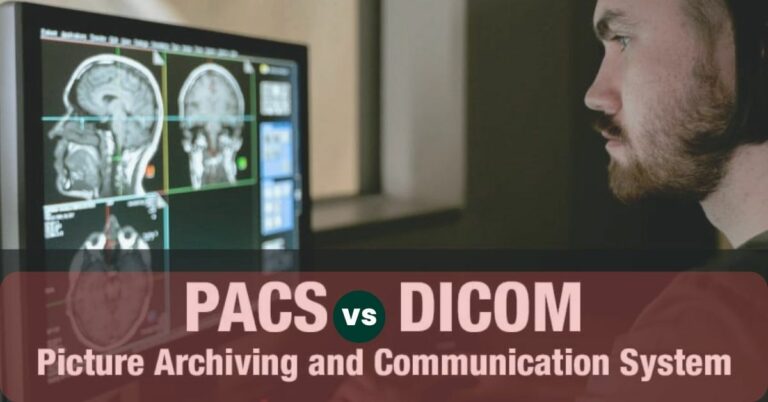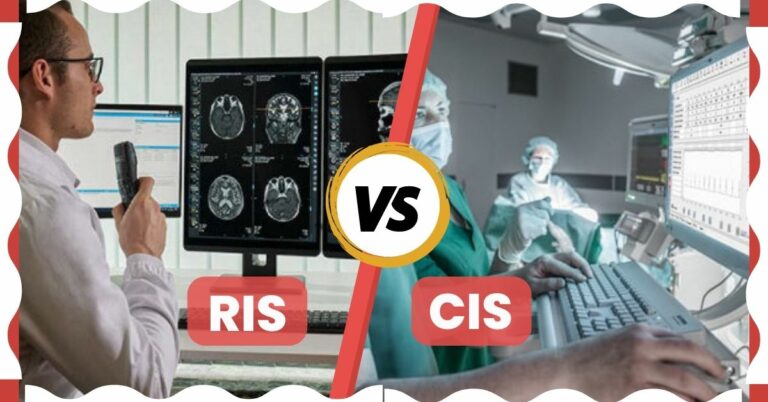DICOM, or Digital Imaging and Communications in Medicine, is a standard for storing and transmitting medical images. DICOM files can be stored on PACS servers, which makes them accessible to doctors and other medical professionals who need to view them. DICOM files can also be sent over the internet, which makes them accessible to anyone with a computer and an internet connection.
Here we are differentiating DICOM & its other terminologies- CIS, RIS & PACS. It would give you an understanding of how they are alike to each other.
Read Also: What is DICOM and How is DICOM Used in Healthcare?
PACS vs DICOM

PACS systems are used to store, retrieve, and distribute digital medical images, while DICOM is a standard for storing and transmitting medical images. DICOM files can be stored on PACS servers, which makes them accessible to doctors and other medical professionals who need to view them.
DICOM files can also be sent over the internet, which makes them accessible to anyone with a computer and an internet connection. PACS systems are typically used in hospitals and other healthcare facilities, while DICOM is more often used by medical device manufacturers and other companies that need to exchange medical images.
Read Also: How DICOM Plays an Integral Role in Healthcare IT Services?
Understanding RIS & CIS
Risk management is the process of identifying, assessing, and managing risks to an organization’s capital and earnings. Risks can come from a variety of sources, including financial markets, operations, legal compliance, and strategic initiatives.
On the other hand, CIS stands for control and information systems. A CIS is a type of software that helps organizations manage their risk by providing a centralized repository for risk data, analytics, and reporting. CISs can be used to identify and assess risks across an organization, track progress on risk mitigation efforts, and measure and report on organizational risk exposure.
How they are used?
Organizations use RIS & CIS tools to make better-informed decisions about how to allocate resources to manage risks effectively. When used correctly, these tools can help organizations reduce their exposure to risk and improve their overall risk management practices.
RIS & CIS tools are not a silver bullet for risk management, but they can be a valuable addition to an organization’s risk management arsenal. When choosing a RIS & CIS tool, it is important to select one that is well-suited to the organization’s needs and that has a robust feature set.
RIS vs CIS

There is a big difference between RIS (Radiology Information System) and CIS (Clinical Information System). RIS is used to store, retrieve, and manipulate data related to radiology. It usually includes a PACS (Picture Archiving and Communication System), which helps in the transmission of images. A CIS, on the other hand, is used to store, retrieve, and manipulate data related to clinical care. It usually includes an EHR (Electronic Health Record), which helps in the management of patient health information.
RIS is mainly used by radiologists, while CIS is used by clinicians. RIS helps in the efficient management of radiology departments. It enables radiologists to store and retrieve images easily. CIS helps in the efficient management of clinical care. It enables clinicians to store and retrieve patient health information easily.
RIS and CIS are both critical for the efficient management of healthcare. However, they are used for different purposes. RIS is used primarily by radiologists, while CIS is mainly used by clinicians. Both systems help in the efficient management of healthcare.
Read more: How Does DICOM Support Big Data Management?
RIS vs DICOM

RIS (Radiology Information System) and DICOM (Digital Imaging and Communications in Medicine) are two standards used in the healthcare industry for storing and transmitting medical images. RIS is a computerized database that stores patient information, while DICOM is a standard protocol used to send and receive medical images over the internet.
RIS systems are used to manage patient information and scheduling, while DICOM systems are used to send and receive images. RIS systems usually have a database of patients, while DICOM only has images. RIS systems can be used to generate reports, while DICOM cannot.
DICOM is the better choice for storing and transmitting medical images, as it is a standard protocol with a wide range of support. RIS is a good choice for managing patient information, but it is not as widely supported as DICOM.
PACS vs CIS
PACS, or picture archiving and communication systems, are used to store, manage, and distribute medical images. PACS systems typically include a central database, a web-based interface, and a variety of software tools. PACS systems are often used by hospitals, clinics, and other healthcare organizations.
CIS, or clinical information systems, are used to store, manage, and distribute medical data. CIS systems typically include a central database, a web-based interface, and a variety of software tools. CIS systems are often used by hospitals, clinics, and other healthcare organizations.
There are many differences between PACS and CIS systems. PACS systems are typically used for medical images, while CIS systems are used for other types of data. Additionally, PACS systems tend to be more expensive than CIS systems. Finally, PACS systems are often more complex and difficult to use than CIS systems. However, both PACS and CIS systems can be very beneficial to healthcare organizations.
Need DICOM or other Healthcare IT Software Solutions?
QSS Technosoft Inc. provides a wide range of DICOM software development services to help you with all your needs. We have a team of experienced healthcare IT developers who are well-versed in DICOM standards and can develop custom solutions that meet your specific requirements. Additionally, we offer various other services, such as DICOM consulting, DICOM training, and DICOM support.
We are proud to mention that our work has been recognized by leading B2B reviews and research platforms like GoodFirms, Clutch, MirrorView, and many more.
Contact us today to learn more about how we can help you with your DICOM needs.


Understanding Key Differences Among DICOM | PACS | RIS | CIS